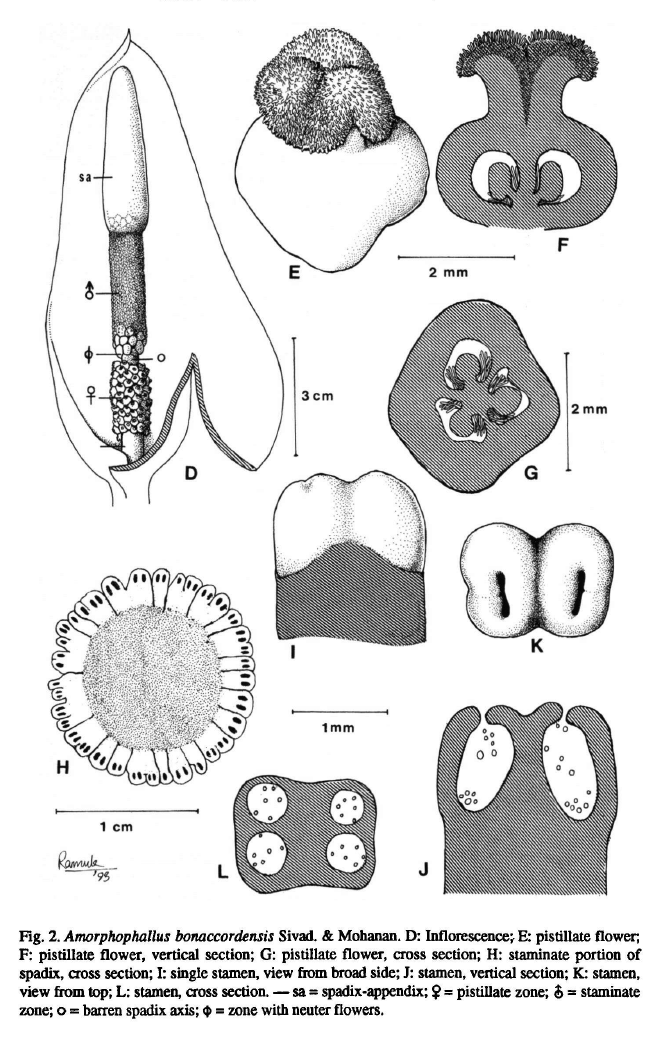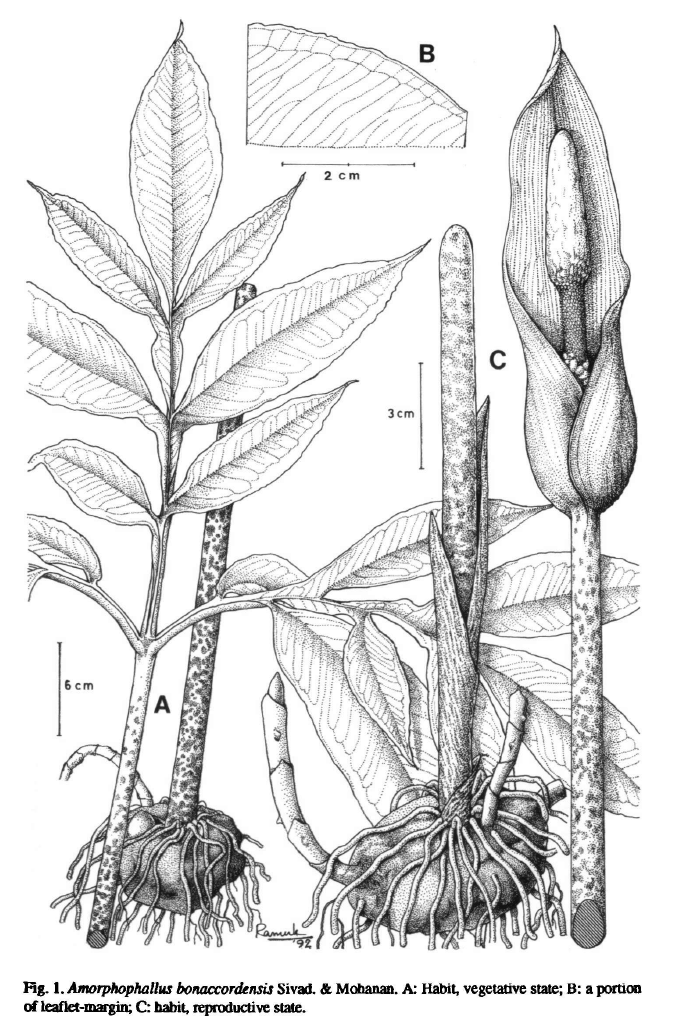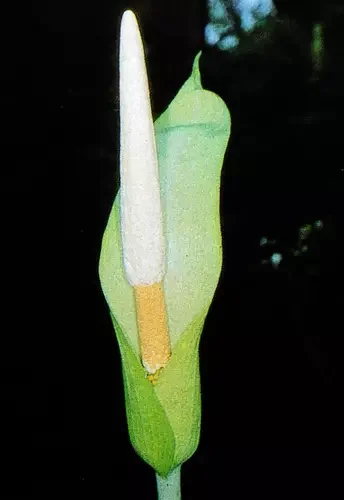AMORPHOPHALLUS BONACCORDENSIS
ORIGINAL DESCRIPTION:
Amorphophallus bonaccordensis Sivad. & Mohanan, spec. nov.
Amorphophallus hohenackeri affinis, a qua imprimis differt marginibus basi spathae convolutis, limbo spathae expanso, spathae inter limbum et tubum leviter constricta, appendice spadicis cylindrica, floribus masculinis 2-5-andri insidentibus contextui albo pulvinato.
Typus: Mohanan TBG & RI 8219 (K holo; CAL, M, TBGT, US iso), India, Kerala State, Trivandrum Dist., Bonaccord on Agathyamala Hill ranges, 700 m, 20-iv-1990.
SYNONYMS:
HOMOTYPIC SYNONYMS: N/A
HETEROTYPIC SYNONYMS: N/A
ACCEPTED INFRASPECIFICS: N/A
DISTRIBUTION: India | Bonaccord or Bonacaud
CLIMATE: N/A
ECOLOGY:
SPECIES DESCRIPTION:
Corms subglobose, 4-8 cm diam., 2.5 cm thick. Leaf trichotomously decompound with petiole cylindric, 30-75 cm long, 0.8-1.6 cm diam. at base, slightly tapering to the tip, smooth, green with dark greenish brown mottles, the latter fewer towards the top portion; rachis of the segments 15-20 cm long, 0.6-0.8 cm thick at base, 0.3-0.5 cm thick at tip, shallowly channeled above and with decurrent leaf bases; leaflets sessile, ovate to oblong, acuminate at apex, acute at base, base unequal and decurrent on rachis, greenish above, paler below, margin wavy, varying in size from 6-13 cm in length and 3-6.5 cm in width; primary veins 15-20 pairs, closely parallel, united below the margin forming a submarginal collective vein. Stolons are produced from the corms of the fertile individuals; stolons cylindric, 4-5 cm long, 0.4-0.7 cm diam., nodes with thin scale leaves and few root primordia.
INFLORESCENCE:
Inflorescence with peduncle cylindric, smooth, 30-75 cm high, 1-1.6 cm diam. at base, gradually narrowed to the tip; identical with petiole in colour and pattern of mottles; spathe ovateoblong, 12-22 cm long, differentiatedinto a basal convolute tube and an upper expanded limb with a shallow constriction in between, tip shortly acuminate, 2.5-3.5 cm diam. at convolute base, 2-3 cm diam. at the constriction, and 3-3.5 cm diam. just above the constriction. Spadix stipitate, 9-18 cm long; stipe to 0.5-1 cm long, 0.5-0.6 cm diam., light greenish; basal portion of 2-3.5 cm of the spadix occupied with pistillate flowers, middle 1-1.5 cm with neuter flowers, upper 3-3.5 cm with staminate flowers, and terminal 4.5-10 cm produced into a sterile cylindric barren appendix; a barren naked zone of 0.2-0.3 cm present between the zones with pistillate and with neuter flowers, respecitvely. Pistillate flowers subspirally arranged; ovary sessile, subglobose, 0.18-0.2 cm high, 0.2-0.3 cm diam., greenish, 2- or 3-loculed, each locule with one subbasal ovule; unicellular trichomes present on funicle and on placenta around the area of funicular attachment; style very short, cylindric, 0.5-0.8 mm long, 0.8-1 mm diam.; stigma 2- or 3-lobed, covered with short unicellularpapillae, cream-coloured, brownish on ageing; neuter flowers in 1-3 rows, creamy white in colour, obovoid, 0.2-0.3 cm diam., few appear to be transitional to the staminate flowers. Staminateflowers closely arranged, each composed of2-5 stamens borne on a white cushion-like tissue of 0.8-1 mm thickness; each stamen 0.1-0.13 cm high, inconspicuously 2-lobed; thecae dehisce by narrow apical horizontal slits; spadix-appendix cylindric, 4.5-10 cm long, 0.8-1 cm diam., rounded at apex, cream in colour, smooth except rarely at the base where it may bear some very shallow rhomboidally oriented projections; becomes warty on ageing; infructescence not observed.
VARIEGATED FORMS: N/A
ETYMOLOGY: The species epithet refers to the Bonaccord (also spelled Bonacaud or Bonakkad), the base station for the Agasthyarkoodam peak, where this species was found.
NOTES: N/A
CULTIVARS: N/A
HYBRIDS: N/A





